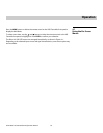
Installation
Vision Model 140/150 Installation/Operation Manual 61
PRE
L
IMINAR
Y
For example, a 1000-Watt lamp can be driven at no more than 1000 Watts. To produce
desired brightness at the screen, a new lamp would likely need less than this maximum
rating — perhaps 812 Watts (example only). Over time, however, the lamp requires more and
more current in order to generate the desired light, until eventually the lamp wattage
reaches its 1000-Watt maximum and the lamp power automatically levels off. At this point,
the tracking function terminates (that is, the power level stabilizes) and the lamp begins to
dim normally. Either reduce your “Intensity” setting or replace the lamp.
Do not lower the “Intensity” so much that the corresponding “Power” value reaches its
minimum — the intensity setting will be inaccurate and cannot be maintained.
Aperture Control: The optical aperture inside the projector controls the diameter of the
light beam passing through the system. With a fully open aperture (slidebar default of “0”),
the maximum amount of light passes through for maximum brightness in your images.
Increase the slidebar setting to reduce the aperture diameter and maximize contrast ratio
instead.
Lamp History (read-only): Lamp History shows the lamps most recently installed and
recorded in the projector. The Lamp History automatically updates whenever you record a
new lamp serial number; the new lamp is added to the end of the list.
Change Lamp: Select Change Lamp from the Lamp menu to record the serial number for a
newly-installed lamp. For detailed lamp replacement instructions, refer to
Lamp and Filter
Replacement on page 81.
1. Lamps become more stable over time, thus a specific intensity is more
easily maintained as the lamp ages.
2. Intensity can be set only if the lamp is in “Intensity” mode
3. Intensity cannot exceed the output of Max Brightness mode.
Note
RVR 7


















